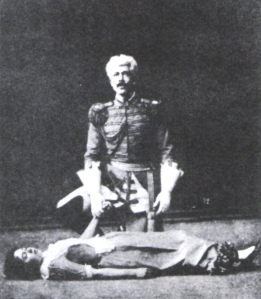
image source
Constantin Stanislavski was a Russian stage actor and director who developed the naturalistic performance technique known as the method of actor training. His influential writing and teaching inspired countless others, notably Stella Adler and Lee Strasberg, associated today with the system of ‘method acting’.
Synopsis
Born in 1863 in Moscow, Russia, Constantin Stanislavski started working in theatre as a teen, going on to become an acclaimed thespian and director of stage productions. He co-founded the Moscow Art Theatre in 1897 and developed a performance process known as method acting, allowing actors to use their personal histories to express authentic emotion and create rich characters. He died in Moscow in 1938.
http://www.biography.com/people/constantin-stanislavski-9492018
Summary
The subject matter
- Classic texts performed in realist settings
- Research as a method of realising the author’s intention
- Plays about ‘real life’
The political purpose or message or dramatic intention
- Socially motivated texts
- The actor as an integral part of the mise-en-scene
- Texts that reflect the life of the audience
- The use of subtext to reveal an emotional context
The actor-audience relationship
- Firmly established ‘fourth wall’
- Audience as voyeur
- The actor removed from any contact with his/her audience
- The actor establishing an interior world. Character based
- An actor dedicated to his/her art
The staging form adopted
- Heavily naturalistic/realistic
- The recreation of reality in stage terms
- Detailed settings with many portable props
Directorial interpretation/production style
- Detailed pre-planning
- Based on a ‘system’
- Seeking the truth in the text by planned rehearsals
- Deeply psychological approach
- An ensemble approach to the text
- A methodical approach to the realisation of the text
Design elements
- Mood and atmosphere created through detailed realist settings
- Natural sound used to create a feeling of place/time
- The theatre of illusion. Confined within the stage picture
- Costumes to replicate those worn in real life
Role of the actors and performance style
- The use of improvisation in the creation of character
- The actor as part of a close-knit ensemble
- Realism/Naturalism. The desire to recreate real life
Technical elements
- The importance of the proscenium as a way of containing the picture
- 19th-century practice harnessed to new interpretations
- Machinery as a way of sustaining illusion
Audience response
- Onlooker through the ‘fourth wall’
- A suspension of belief
- Seeking confirmation of their own bourgeois place in the world
- A desire to see great acting at work in the re-creation of character